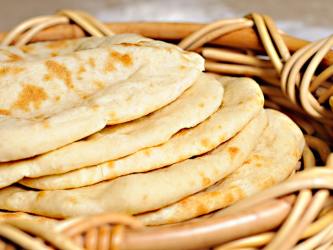Naan

Naan or nan is a leavened, oven-baked flatbread. It is typical of and
popular in West, Central and South Asia.
Etymology
The earliest appearance of "nan" in English literature dates back to 1810,
viz. in a travelogue of William Tooke. The original Persian word nān 'bread'
is already attested in Middle-Persian/Pahlavi as 'bread, food'.
The form Naan has a widespread distribution, having been borrowed in a range
of languages spoken in central and south Asia, including present-day India,
Pakistan, Bangladesh and the surrounding regions.
In these countries and regions, the generic designation "Naan" refers to a
kind of (in most cases) flatbread, baked according to locally adapted
recipes. The spelling Naan is first attested in 1979, and has since become
the normal English spelling.
Description
The most familiar and readily available varieties of Naan in Western
countries are the South Asian varieties. In Iran, from which the word
ultimately originated, nān does not carry any special significance, as it is
merely the everyday word for any kind of bread. Naan in other parts of South
Asia usually refers to a specific kind of thick flatbread (another
well-known kind of flatbread is chapati). Generally, it resembles pita and,
like pita bread, is usually leavened with yeast or with bread starter
(leavened Naan dough left over from a previous batch); unleavened dough
(similar to that used for roti) is also used. Naan is cooked in a tandoor,
from which tandoori cooking takes its name. This distinguishes it from roti,
which is usually cooked on a flat or slightly concave iron griddle called a
tava. Modern recipes sometimes substitute baking powder for the yeast. Milk
or yogurt may also be used to impart distinct tastes to the Naan. Milk used
instead of water will, as it does for ordinary bread, yield a softer dough.
Also, when bread starter (which contains both yeast and lactobacilli) is
used, the milk may undergo modest lactic fermentation.
Typically, it will be served hot and brushed with ghee or butter. It can be
used to scoop other foods, or served stuffed with a filling: for example,
keema Naan is stuffed with a minced meat mixture (usually lamb or mutton or
goat meat); another variation is peshawari Naan. Peshawari Naan and Kashmiri
Naan are filled with a mixture of nuts and raisins; in Pakistan, roghani
Naan which is sprinkled with sesame seeds; Kulcha is another type. Amritsari
Naan also called as amritsari kulcha is stuffed with mashed potatoes, onion
(optional) and lots of spices. Possible seasonings in the Naan dough include
cumin and nigella seeds. The Pakistani dish of balti is usually eaten with a
Naan, and this has given rise to the huge karack or table Naan, easy to
share amongst large groups.
A typical Naan recipe involves mixing white flour with salt, a yeast
culture, and enough yogurt to make a smooth, elastic dough. The dough is
kneaded for a few minutes, then set aside to rise for a few hours. Once
risen, the dough is divided into balls (about 100 grams or 3.5 oz each),
which are flattened and cooked. In Pakistani cuisine, naans are typically
graced with fragrant essences, such as rose, khus, or (vetiver) with butter
or ghee melted on them. Nigella seeds are commonly added to Naan as cooked
in Indian restaurants throughout the UK.
Raisins and spices can be added to the bread to add to the flavour. Naan can
also be covered with, or serve as a wrap for, various toppings of meat,
vegetables, and/or cheeses. This version is sometimes prepared as fast food.
It can also be dipped into such soups as dal, and goes well with sabzis
(also known as shaakh).
Naan bya in Burma is sometimes served at breakfast with tea or coffee. It is
round, soft, and blistered, often buttered, or with pè byouk (boiled peas)
on top, or dipped in hseiksoup (mutton soup).
The Naan burger is a regular hamburger served on Naan bread. The dish is
served by KFC in India, and also sold in Canada, and may have originated in
Britain where both American and Indian food are popular and available in
most markets.
Sources: Wikipedia
undo ...back